Rockwell Files: Commuters
Norman Rockwell’s 1946 cover Commuters was a tribute to fellow artist and friend Anna “Grandma” Moses, who painted in a folk-art style, rarely using perspective to convey distance. Hence, her landscapes appeared flattened and tilted forward so everything in the panorama could be seen. Commuters uses a similar style to portray Tuckahoe, New York, a very flat town that rises here like an Alpine village in the background. But the improbable landscape allowed Rockwell to make all the houses and cars of the neighborhood visible.
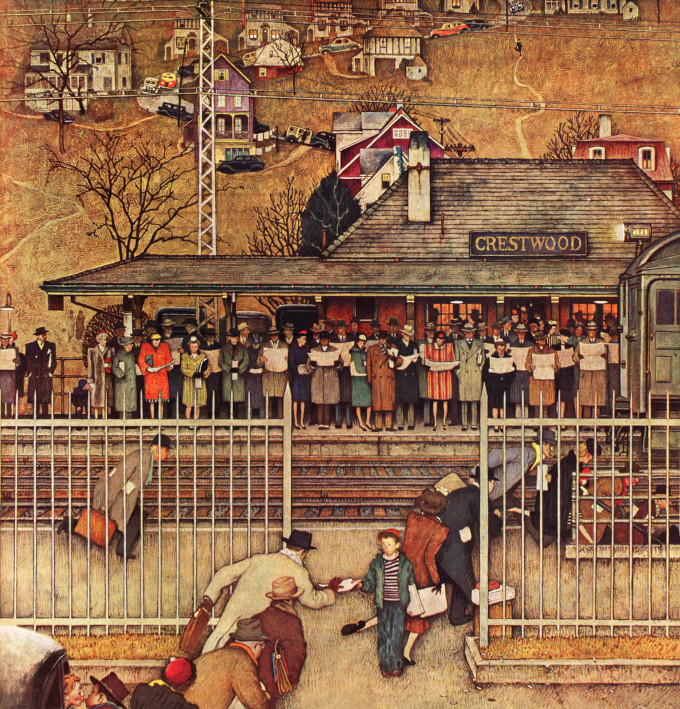
Grandma Moses, who only took up painting in her 70s, said she wanted her works to capture “how we used to live.” Similarly, Rockwell’s cover evokes a morning rush hour from 74 years ago that takes us back in time. Reflecting the rising postwar flight to the suburbs, Crestwood Station, a stop on the Harlem Line into New York, is crowded with well-dressed commuters. Notice how, in those days, hats were de rigueur out of doors — one exception being the housewife in curlers kissing her husband goodbye (bottom left). For a parallel to the modern commuter, notice the rapt attention each one has to their own newspaper — no socializing, no chatter. Today, of course, all that attention would be devoted to a phone.
Featured image: Norman Rockwell / SEPS
This article is featured in the September/October 2020 issue of The Saturday Evening Post. Subscribe to the magazine for more art, inspiring stories, fiction, humor, and features from our archives.
Cartoons: Getting from Here to There
Want even more laughs? Subscribe to the magazine for cartoons, art, inspiring stories, fiction, humor, and features from our archives.
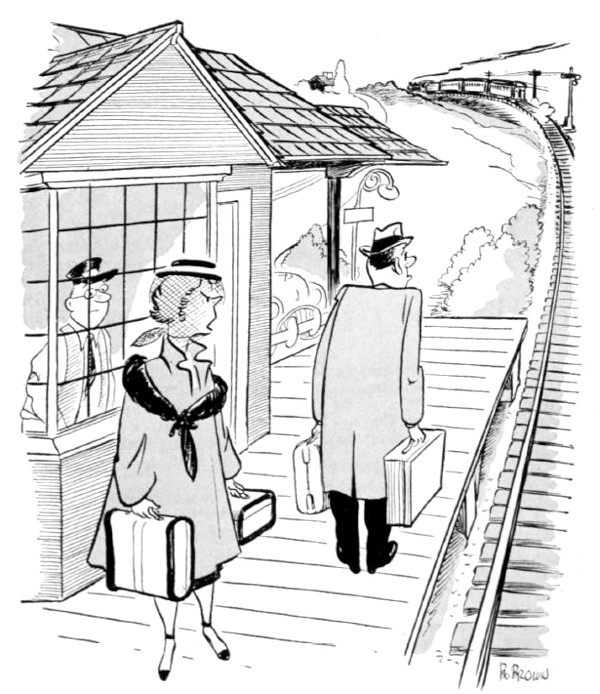
Bo Brown
June 30, 1951
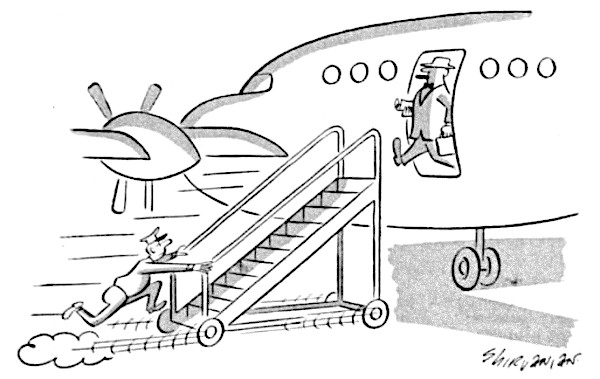
June 21, 1952
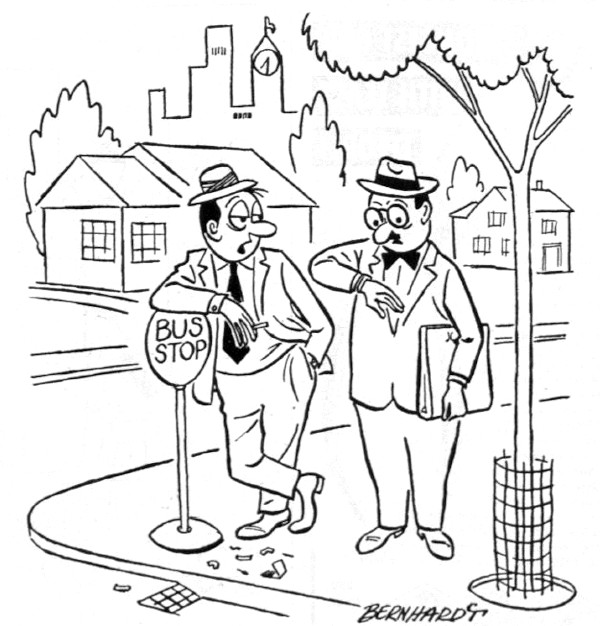
Bernhardt
May 19, 1951
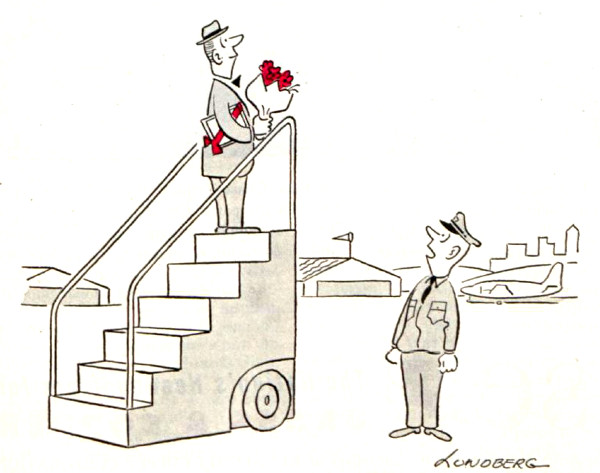
Lundberg
May 10, 1952
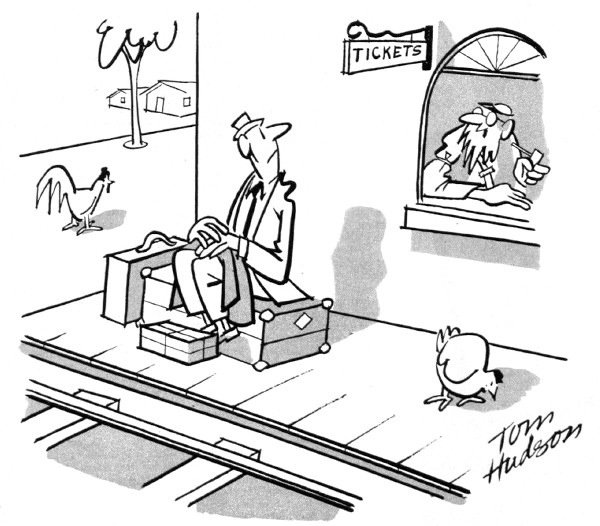
Tom Hudson
May 28, 1951
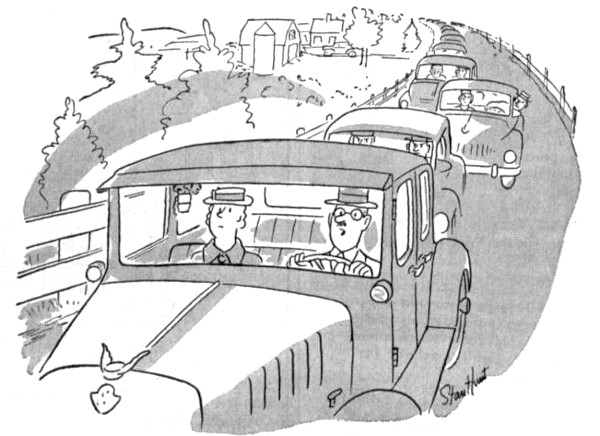
Stan Hunt
November 22, 1952
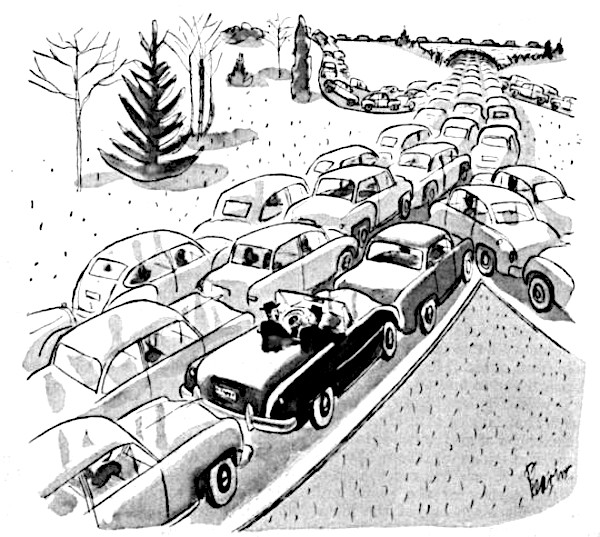
October 25, 1952
Want even more laughs? Subscribe to the magazine for cartoons, art, inspiring stories, fiction, humor, and features from our archives.
Why Traffic Jams Are Never Your Fault
I have a problem with Chicago.
Every time I’m in the city, I find myself surrounded by terrible drivers. The highway traffic is dense, of course, but Chicagoans have a habit of exacerbating the congestion by driving with impatience and mania. They follow too closely, brake too often, and cause me unnecessary stress while I’m trying to enjoy WBEZ and daydream about a weekend in Andersonville.
The weird thing is that St. Louis drivers are the same way! Dallas and Denver, too. Bad drivers seem to follow me — an exemplary motorist — everywhere.
I talked to Benjamin Seibold to get some clarity on everyone else’s bad driving. Seibold is an Associate Professor of Mathematics at Temple University and the director of the Center for Computational Mathematics and Modeling, and he says that the tendency for traffic to become a stop-and-go situation is as natural and dependable as the winds of Lake Michigan.
Seibold has spent years researching “phantom traffic jams.” These are traffic jams resulting in stop-and-go traffic that occur for no apparent reason. We’ve all experienced one: you’re driving along in moderate to heavy traffic and suddenly there’s a holdup. Once you’re able to get up to speed again you realize there wasn’t an accident or construction site to cause the jam. So what gives?
“With congestive flow, it’s clear that everyone will go slower, but it would be possible for everyone to go slowly but steadily. Once traffic density reaches a certain threshold, then this uniform speed is dynamically unstable,” Seibold says. “So, that instability means that if you perturb the system a little, it doesn’t go back to it; it moves away from it.” In other words, we are scientifically unable to maintain good traffic flow during rush hour. Phantom jams are the result of collective driving behavior. Those small perturbations — engine hiccups, lane changes, decreases in speed from road curves or otherwise — amplify congestion in traffic.
Phantom jams are inevitable whenever human drivers are involved. To prove this, Seibold’s team performed an experiment in which 21 drivers drove in a circle. They created traffic waves (stop-and-go traffic) that resulted from the cumulative speed imperfections of all drivers in spite of each individual driver behaving somewhat predictably.
Video of how a jamitron progresses on a circular road. (Source: http://math.mit.edu/projects/traffic/)
The problems with stop-and-go traffic, other than being an annoyance, are that it’s costly and dangerous. Fuel consumption, and therefore emissions, is higher during traffic jams, and accidents are more likely. As Seibold puts it, “A higher number of strong braking events in travel is an indicator of collision risk, and traffic jams create these conditions in abundance. Uniform travel flow results in less than five percent of strong braking events.”
In the aforementioned experiment, Seibold’s team found a remedy to the traffic waves that made a significant difference. By inserting one autonomous car into the circle of human drivers, the researchers were able to stabilize the traffic waves caused by the 21 hopelessly flawed drivers. In the traffic scenario without the self-driving car, overall fuel consumption was 40 percent higher, but when the self-driving car was included, emissions of carbon dioxide were decreased by 15 percent and nitrogen oxides by 73 percent.
Does this mean we should be releasing fleets of robot cars to keep us in line on the highways? Or at least in Chicago? Maybe, but widespread driverless vehicles could still be many years away. There are other practical solutions, like variable speed limits shown on LED signs or ramp meters to control highway merging. These fixes can only go so far, however, and, as Seibold says, they depend largely on driver compliance and awareness.
So why not just teach people to be better drivers? While we might never be able to display the perfect vehicular control of a self-driving car, surely we could improve the overall flow of traffic by encouraging a steady gas foot. After all, the U.S. Forest Service’s recommendations for eco-driving seem to line up with the kind of driving that stabilizes traffic flow: smooth and slow acceleration and deceleration, maintaining a constant speed, etc. Seibold says it’s a long shot. “There is no way to naturally change the way people drive like this on a large scale,” he says.
These traffic waves exist independently of many other variables of travel. The fundamental laws of traffic flow are relatively uniform all over the world. Other countries have very different laws for highway speeds and overtaking, but it turns out that traffic flow, as it is impacted by density and how stop-and-go traffic happens, are rather similar in all countries, Seibold says. That said, generally in the southwest U.S., people are more accepting of traffic flow, and on the east coast there is more aggressiveness in driving behavior that can make jams more severe.
To Professor Seibold, the most interesting thing about studying traffic is finding the behavioral patterns that emerge in complex human systems that are not initially visible. To a mathematician, these patterns, like traffic waves, resemble phase transitions (like vaporization) or detonation waves (explosions). “If we want to improve our traffic systems,” he says, “understanding the connections between these phenomena is important.”
So, the movement of individuals is as predictable as natural laws and apparently not guided by some city-wide ignorance. Perhaps Chicagoans aren’t especially bad drivers. Regardless, on my next trip, I’ll be taking the train.
Featured Image: Repina Valeriya on Shutterstock
A Plea for Asphalt
At the turn of the century, Post editors saw a dangerous trend in stately old trees being cut down to make way for paved roads, and responded with this sardonic editorial.
That a healthy sentiment in favor of asphalt in place of trees is arising in the minds of political leaders is shown by the demolition of what some sentimentalist has called “noble old elms.” Every few days we read of an enlightened city government that has “ruthlessly” swept away a long row of trees.
What has made Central Park the success that it has been? It’s the asphalt walks that make the simultaneous trundling of a baby carriage and an innocent flirtation perfectly feasible. But let us go further; let us cut up the sod of the common and let in a sea of asphalt, and we will have a paradise for roller-skating, carriage trundling, and bicycling.
Let the endless avenues of elms that “adorn” some of our cities be cut down, and let in the glad sunlight and the merry asphalt.
Give us asphalt!
—“A Plea for Asphalt,” editorial by Charles Battell Loomis, December 9, 1899
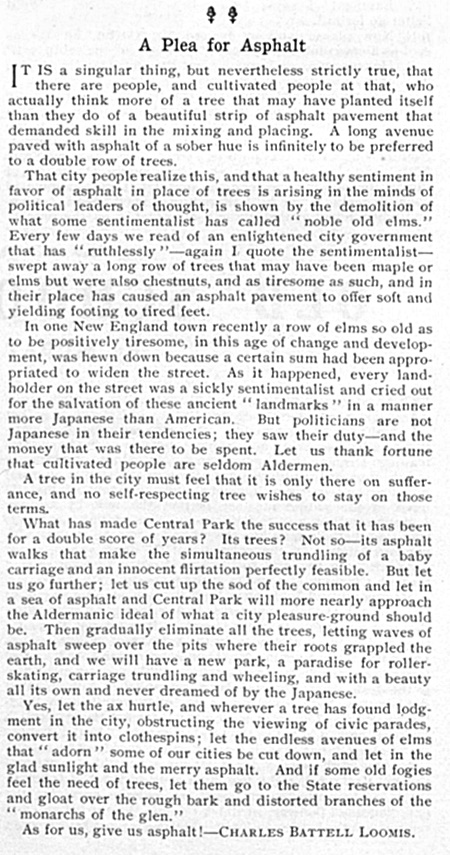 This article is featured in the May/June 2019 issue of The Saturday Evening Post. Subscribe to the magazine for more art, inspiring stories, fiction, humor, and features from our archives.
This article is featured in the May/June 2019 issue of The Saturday Evening Post. Subscribe to the magazine for more art, inspiring stories, fiction, humor, and features from our archives.
Featured image: Shutterstock